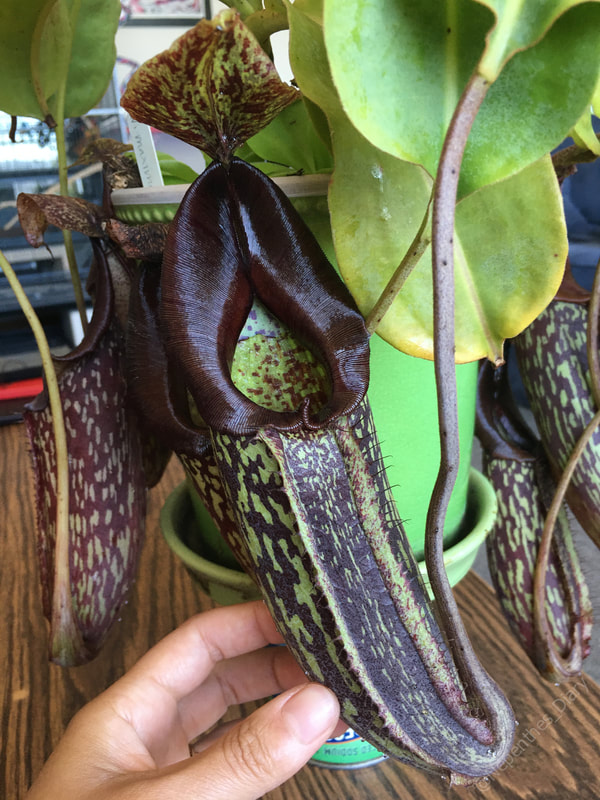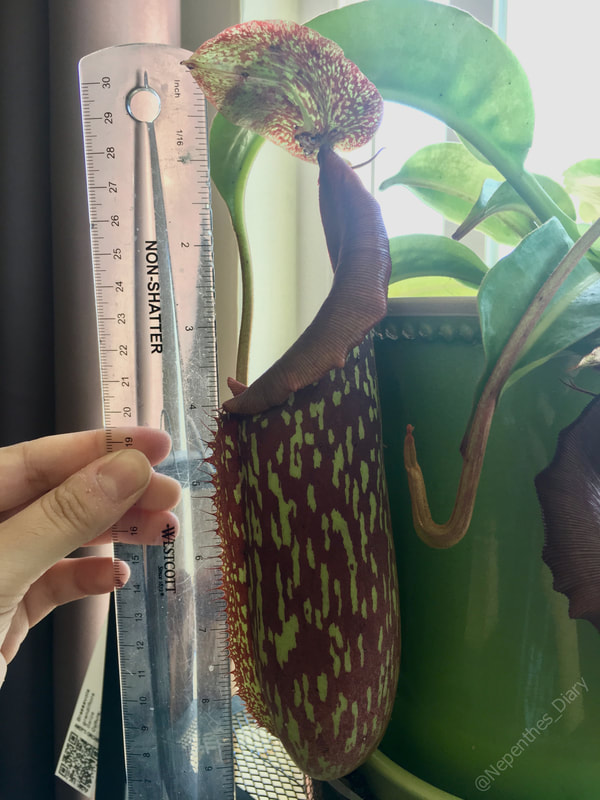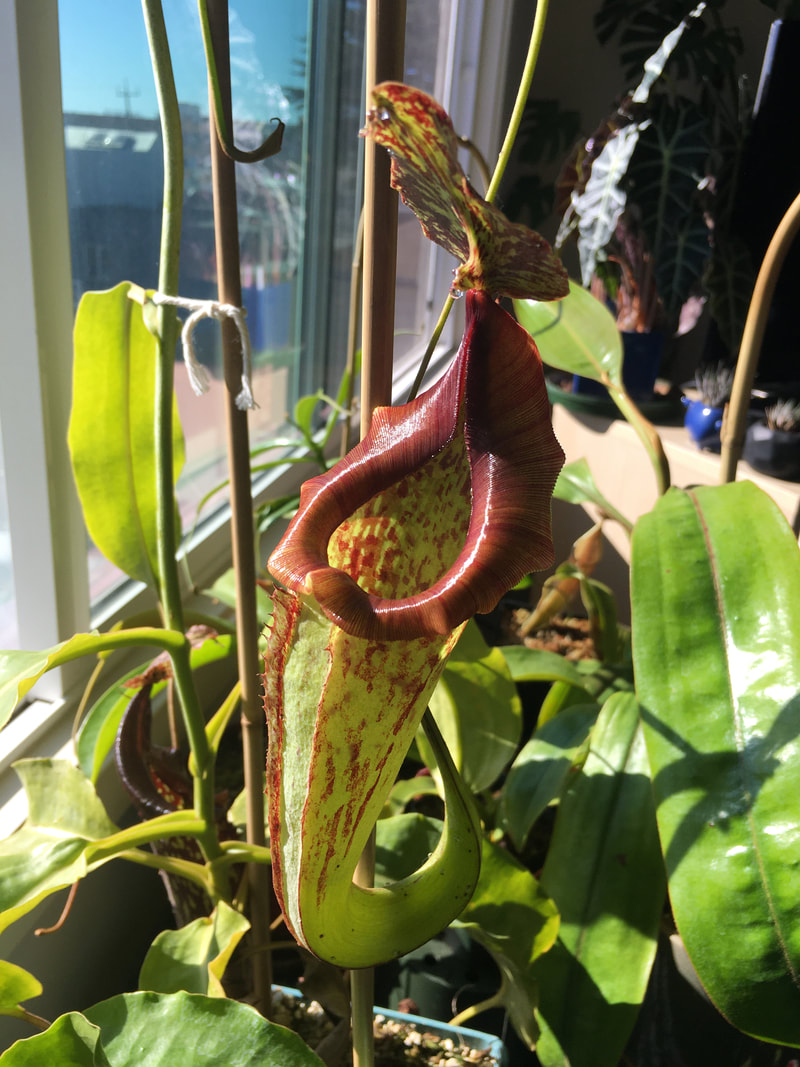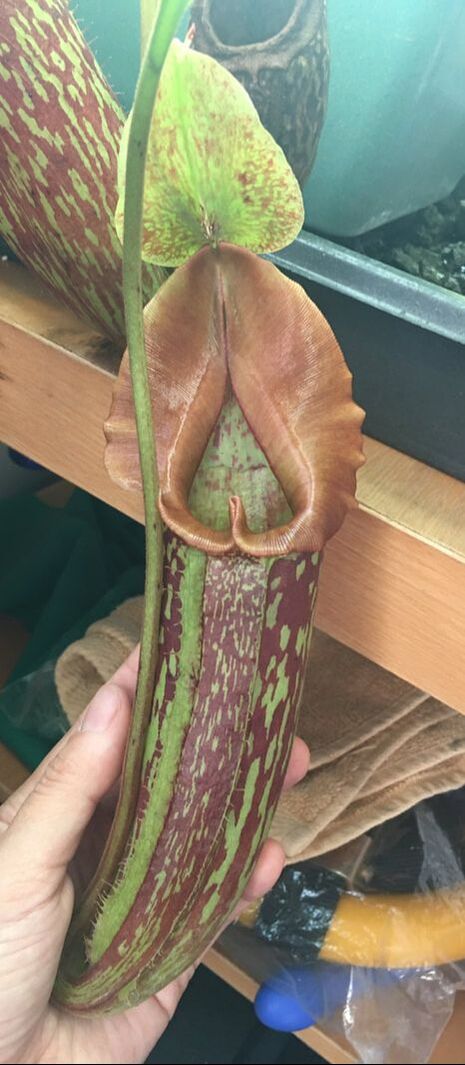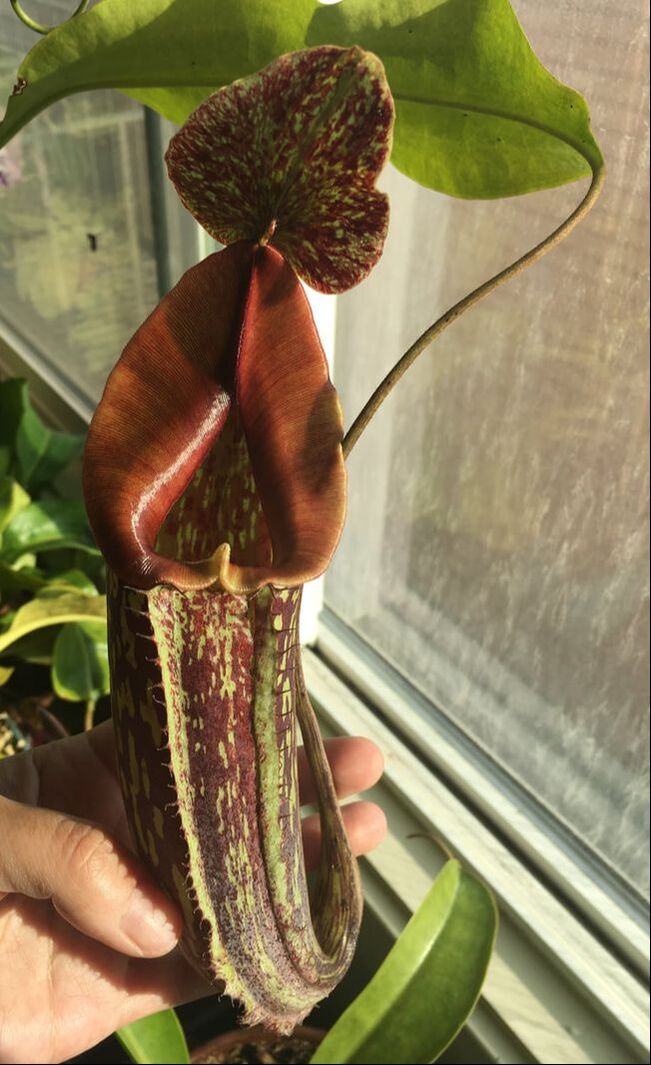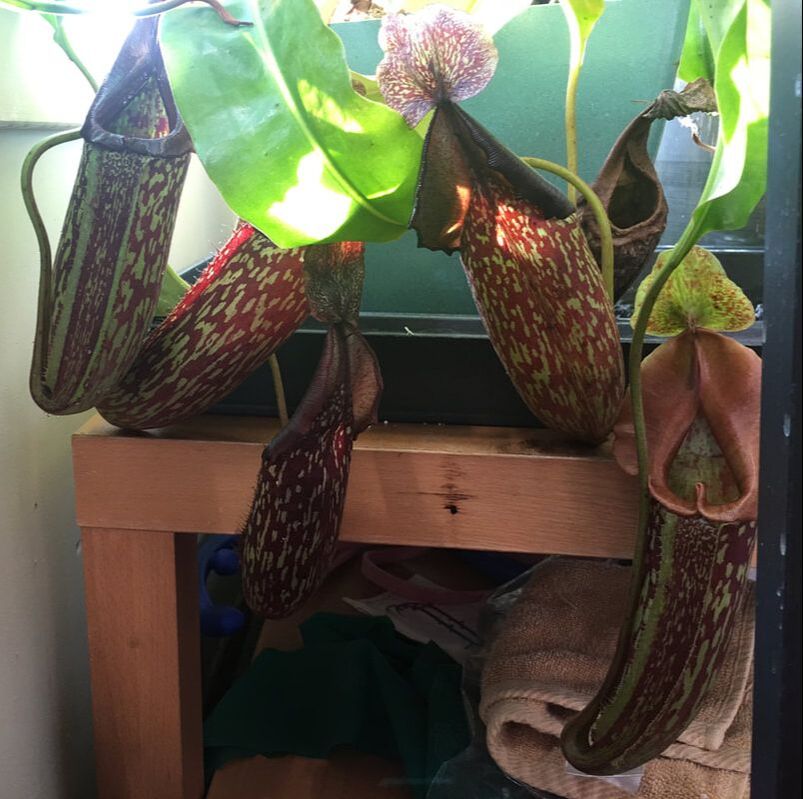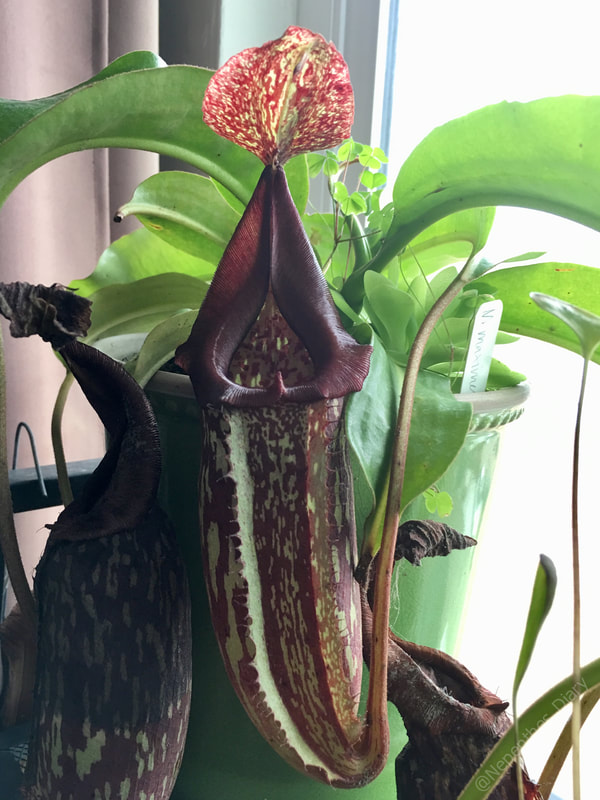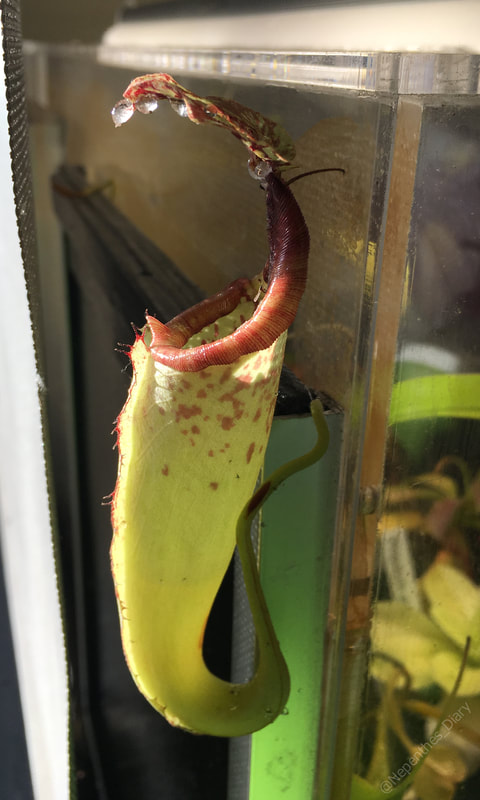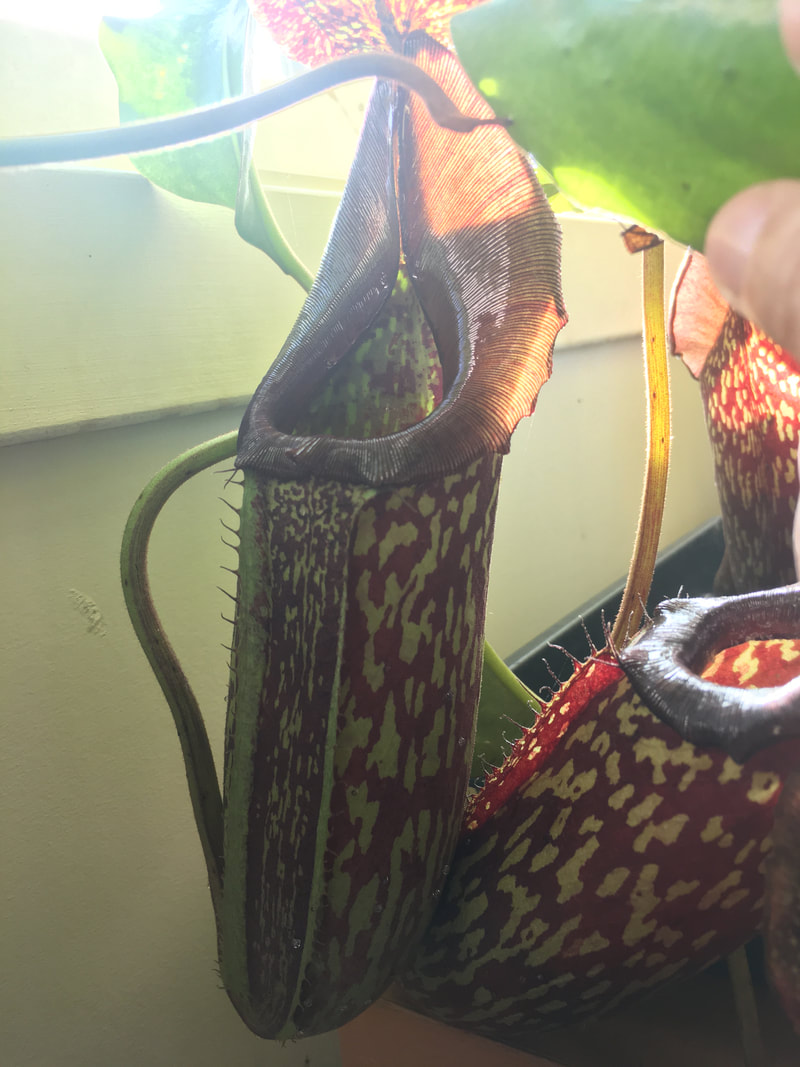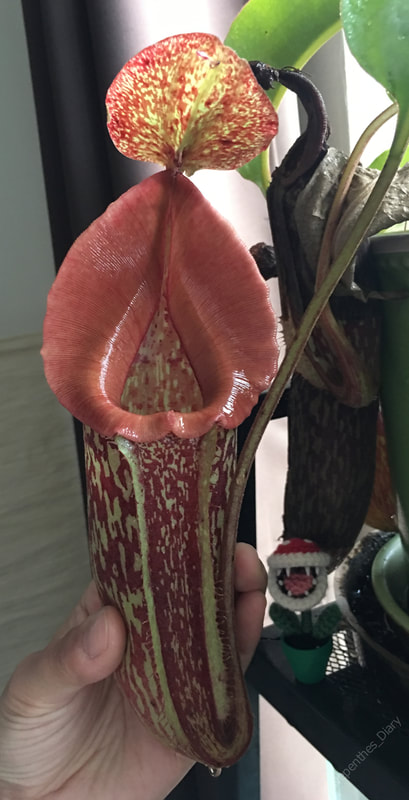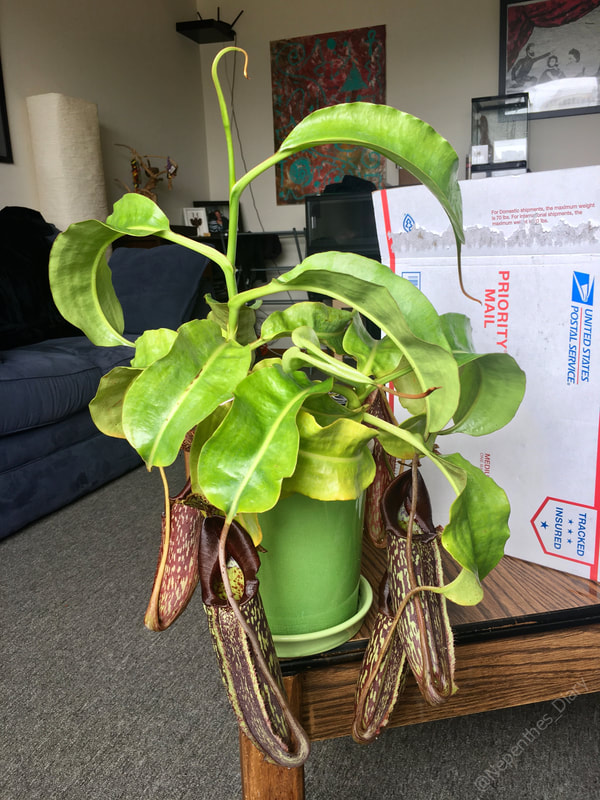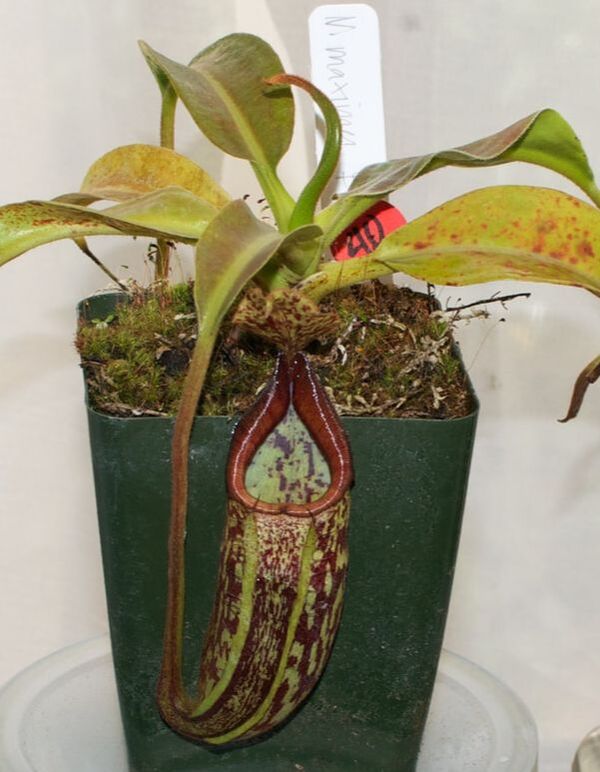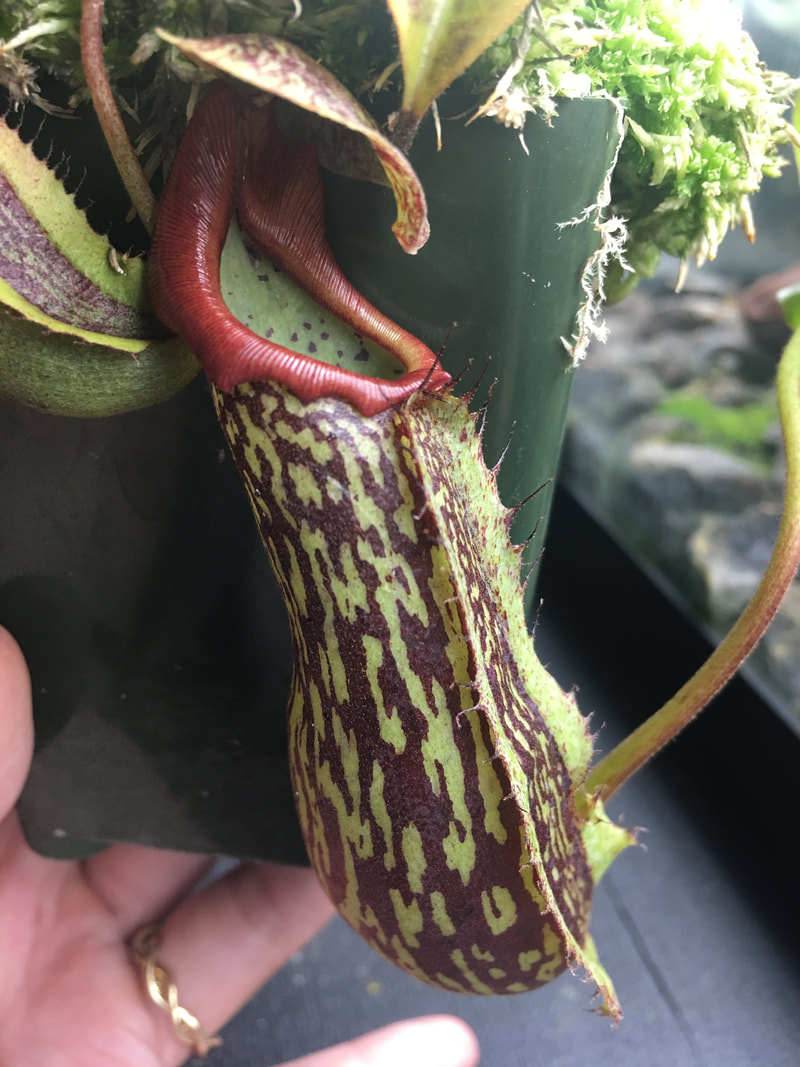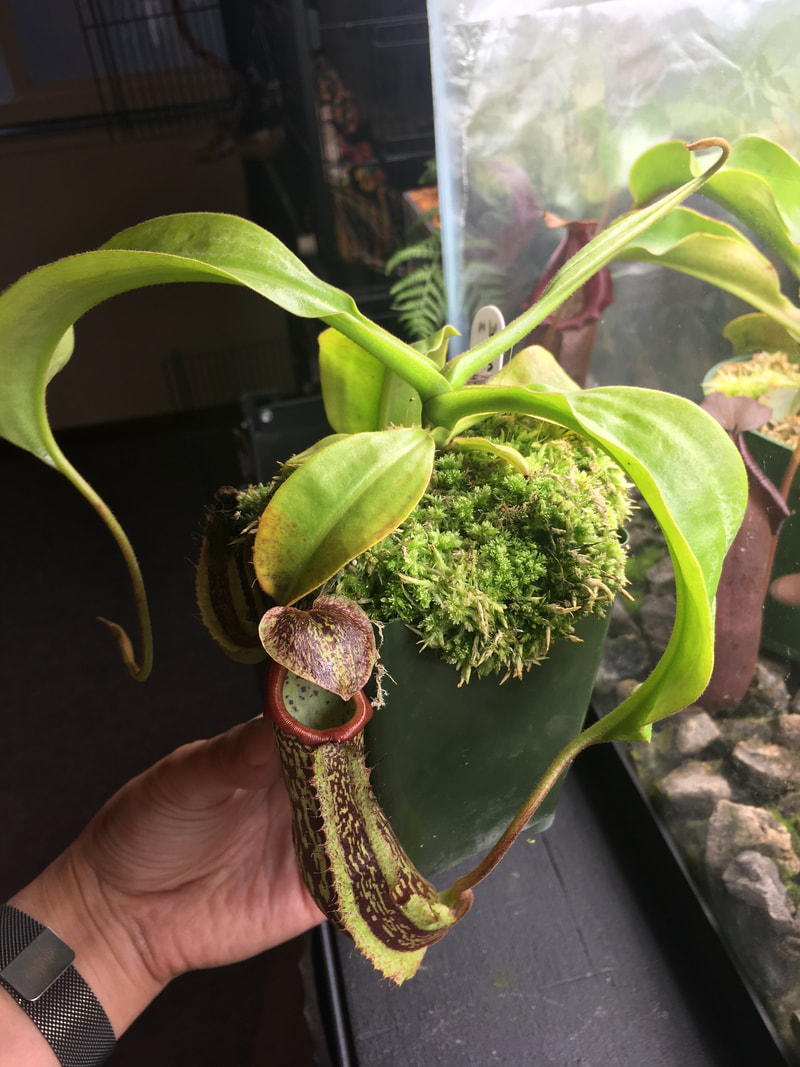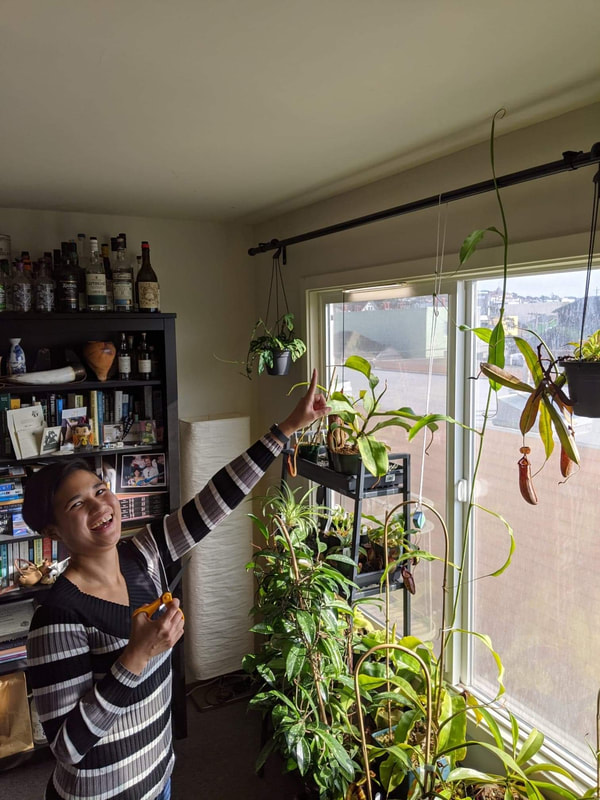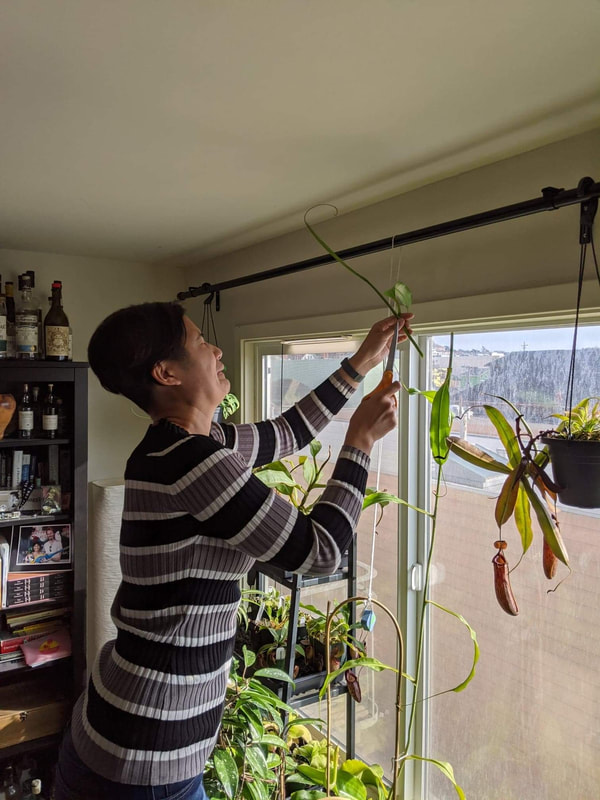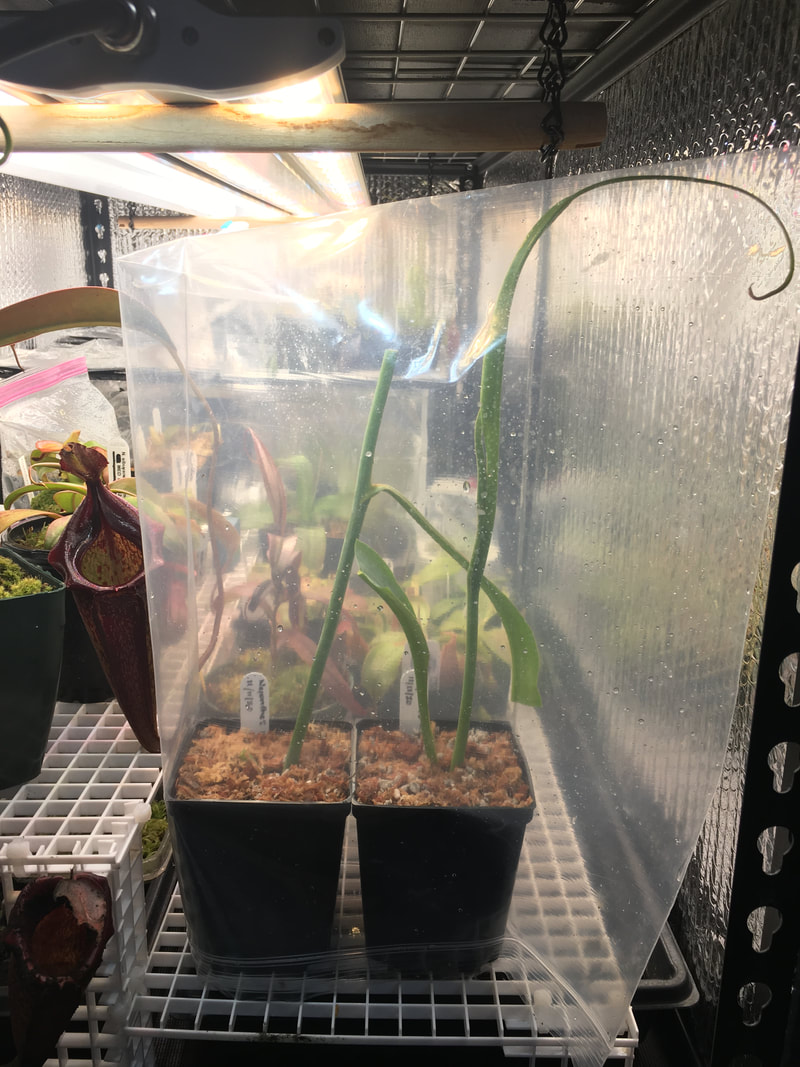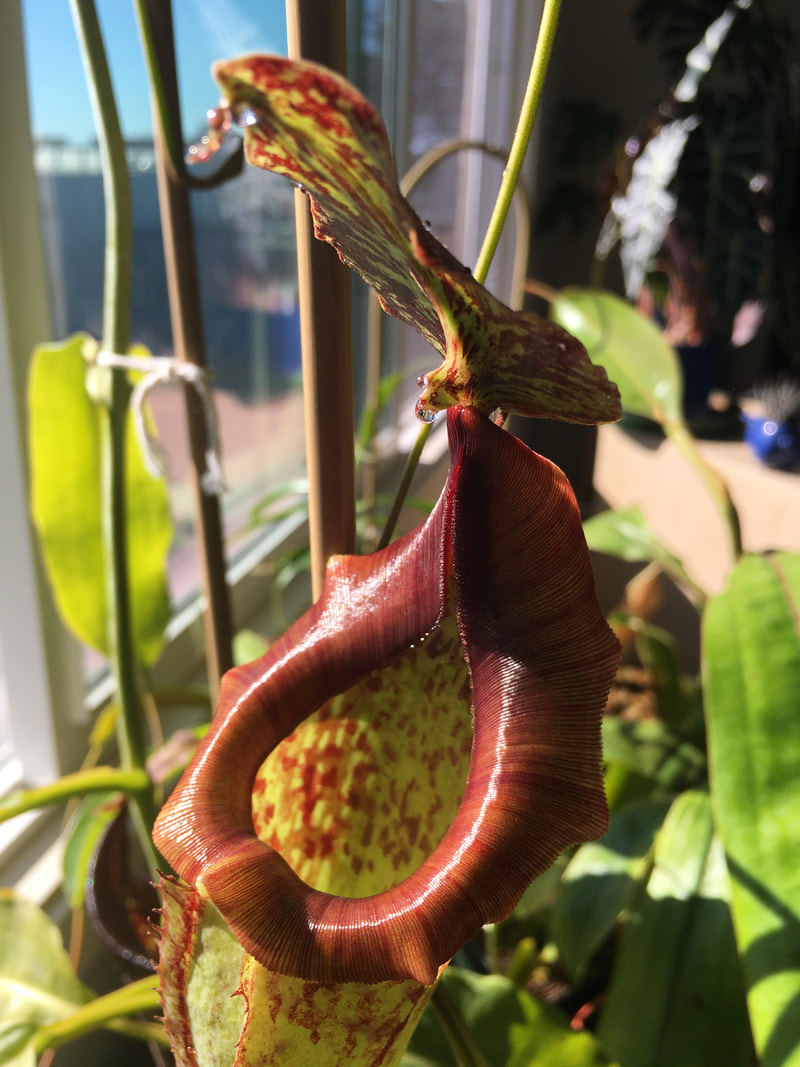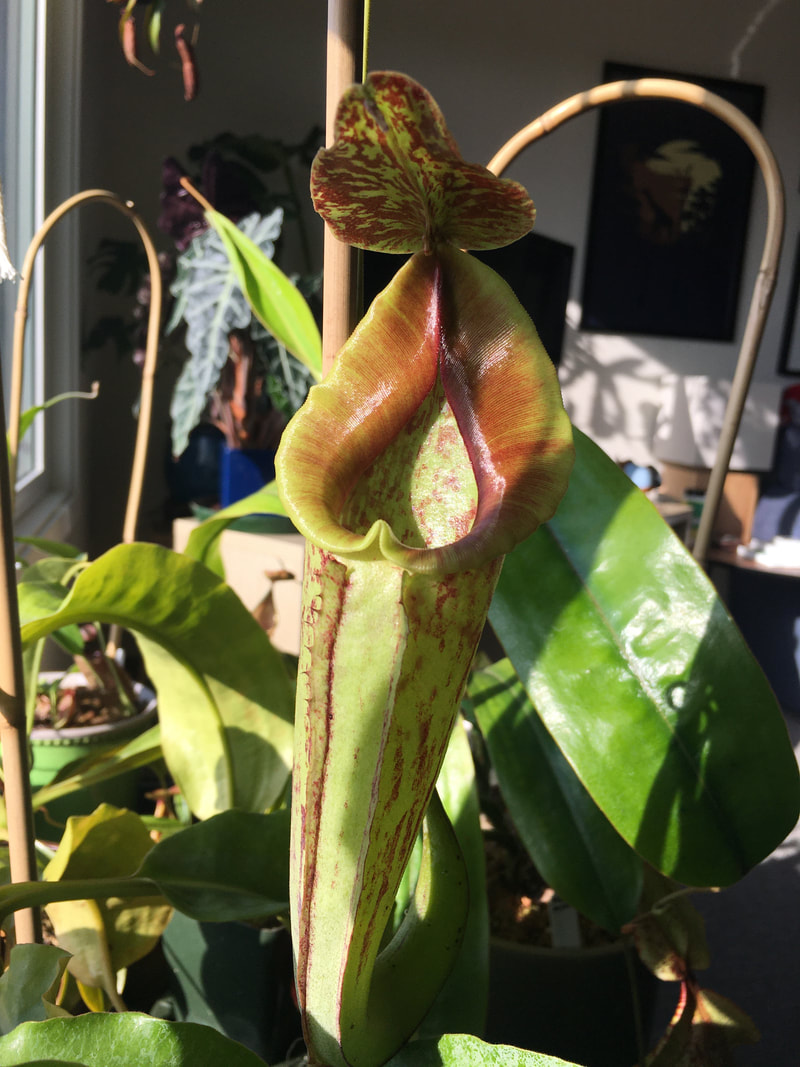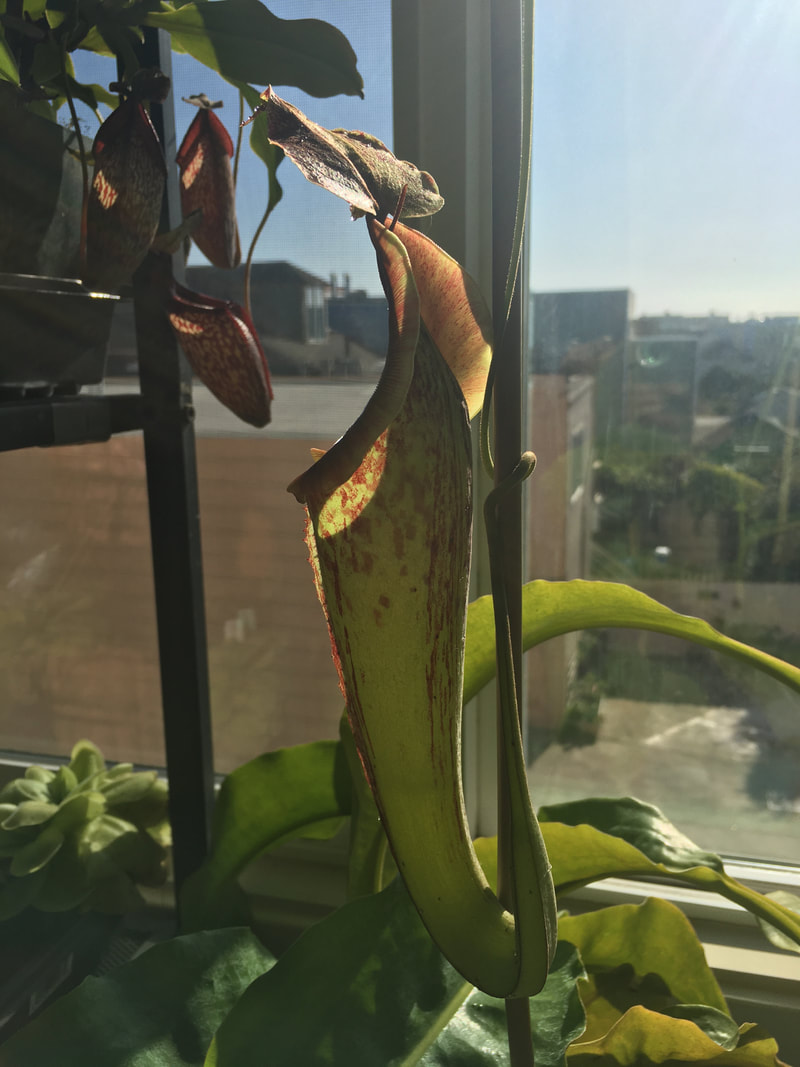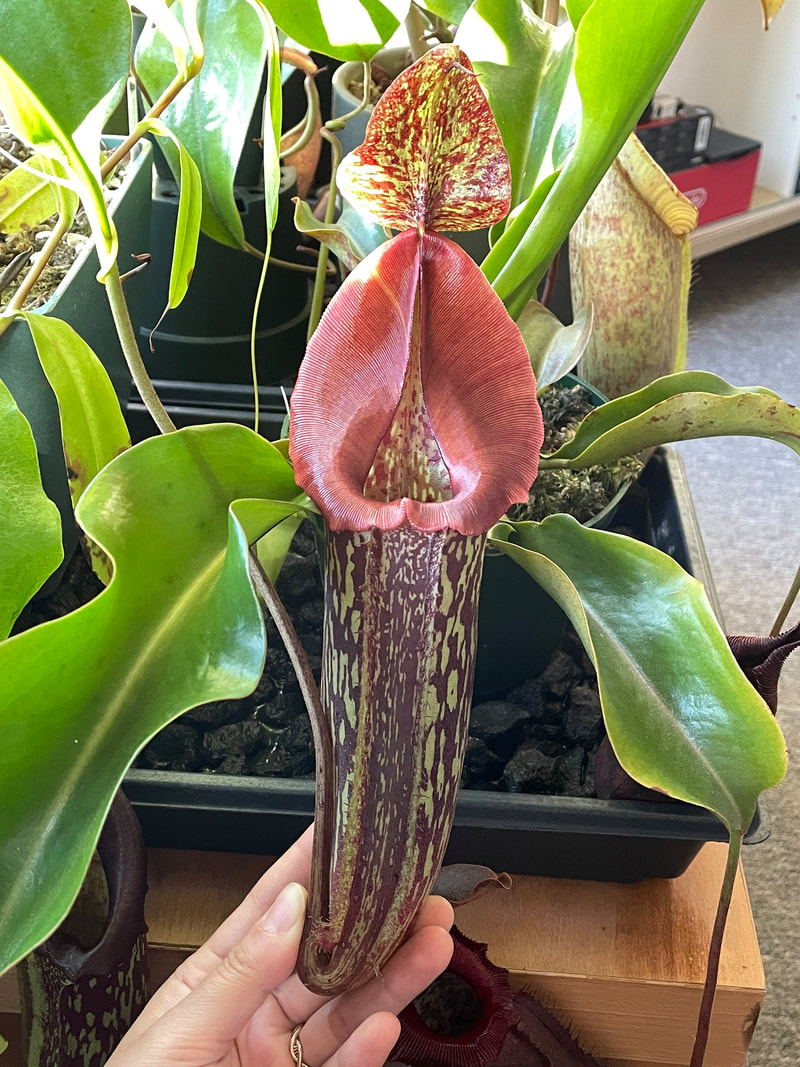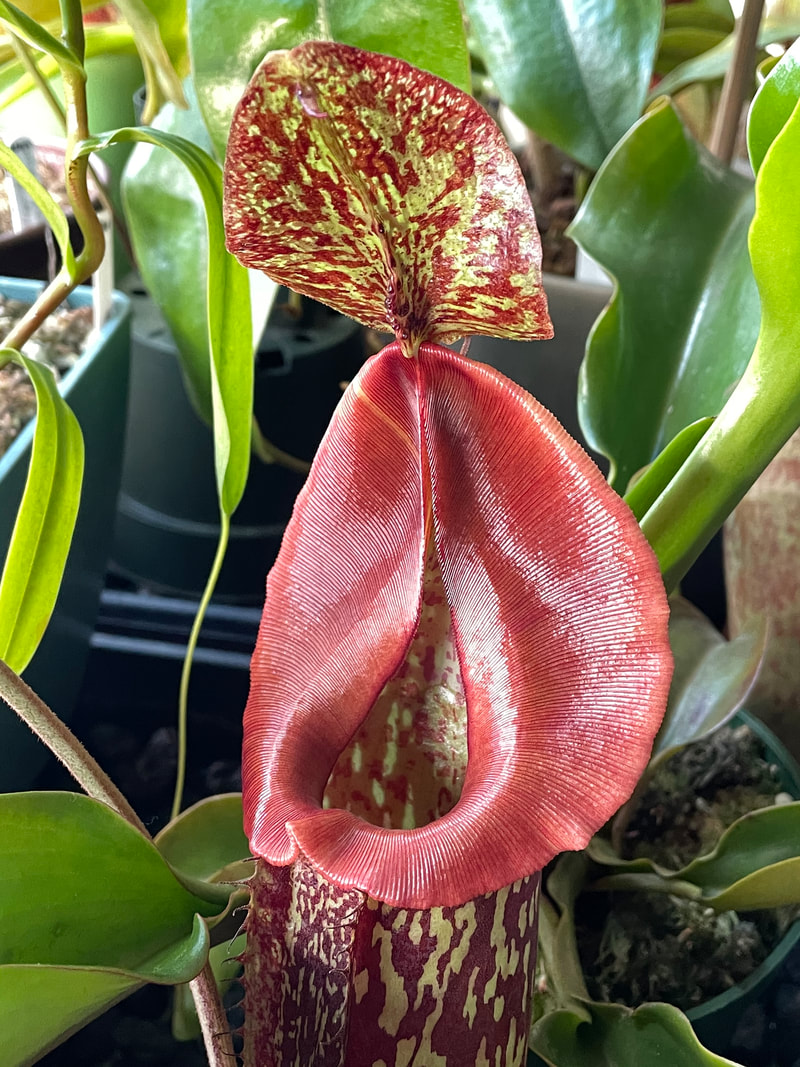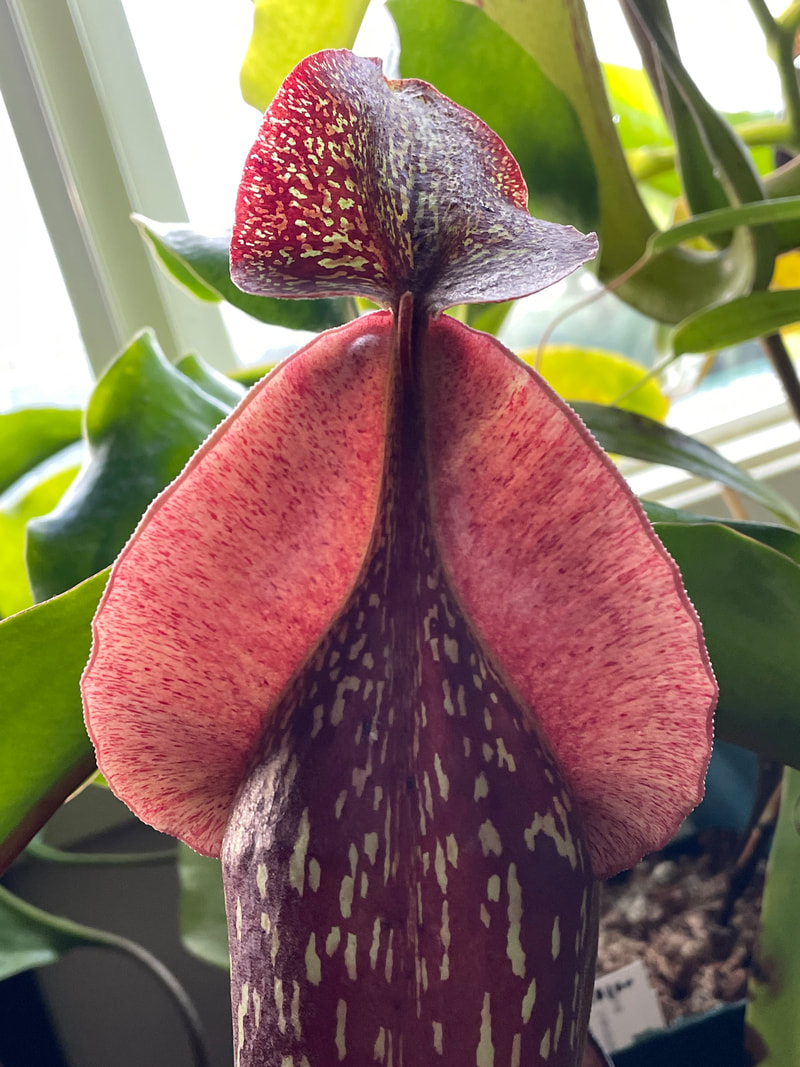|
A gorgeous Nepenthes with a mysterious past, N. maxima come in many forms, but this one is by far my favorite - very large, beautifully dark speckled pitchers with extremely wide flaring peristomes that never roll back completely!
|
The history of Nepenthes maxima is an interesting one, filled with mystery. Although modern Nepenthes growers refer to this highly variable species as Nepenthes maxima, it was at one time called Nepenthes curtisii and was one of the first Nepenthes to enter cultivation during the Victorian era. At first unimpressive, the species gained popularity as it matured in the Veitch Nursery greenhouse and was used in many famous Victorian era hybrids, including Nepenthes x tiveyi and Nepenthes x Dyeriana. Below is an account on the original Nepenthes curtisii in the 1889 Gardener's Chronicle.
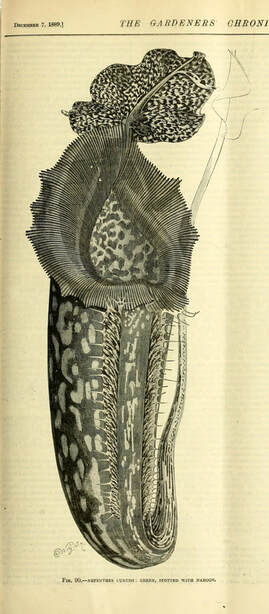
"Two years ago (Dec. 3, 1887) we published a description, and gave a page illustration of a handsome Nepenthes, introduced from Borneo by Mr. Curtis to Messers. Veitch's nurseries. In that description we said that the large pitchers are "likely to improve under cultivation." Well! they have done so. Nepenthes Curtisii, as now seen at Messers. Veitch's, and as exhibited by them recently, has improved so considerably as a decorative plant that, fine as we then thought it to be, it is so much finer now that we have not hesitated to commission Mr. Worthington Smith to make another illustration, in order to render justice to the plant (see fig. 90). The ground colour is a dull Apple-green, the spottings reddish-purple. Our artist says "intense liver," which reads undigestibly! Happily the botanical characteristics remain as before, so that, with the exception of the dimensions, no material alteration need be made to the account given at p. 681 (Dec. 3, 1887). The peculiarity distinctive of this species lies in the presence of two teeth-like projections, from under the side of the lid from the base and from near the apex respectively. This is a peculiarity which, in the interests of science needs investigation and watching, while it certainly adds to the appearance of the pitcher."
I haven't been able to find any good primary sources on when the species went from being known as Nepenthes curtisii to Nepenthes maxima. Although the early descriptions and drawings of Nepenthes curtisii certainly seem to match the modern N. maxima, especially my particular variety, the real answer may be permanently shrouded in mystery. Bruce Lee Bednar discusses this mysterious nomenclature in his article 1987 "Old Clone, New Hybrid".
|
"Today, in cultivation, an unusual female Nepenthes clone is going by the name of N. curtisii as well as N. spectabilis (not to be confused with the true Sumatran species). Where did it come from? What do we really know about it? Well, in 1883-84, on Curtis' second mission to Malaysia, he collected and sent home two species previously unknown. One was a variety after himself, Nepenthes curtisii, the other which was similar and supposed to be a variety of N. curtisii was later given specific rank as a species by Dr. Masters who described it to be stenophylla. Later, Danser wrote that N. curtisii was simply a form of N. maxima, to which I do not agree at all. Almost everyone then, as well as today, fail to notice, both in the upper and lower pitchers, when they first open, a clear, well-defined, solid white band that encircles the peristome. As the peristome matures, it folds down over the white band, completely hiding it. This, as well as the fine hairy texture to the leaves, seem to indicate the plant is a natural hybrid between N. maxima and N. albo-marginata. No plants resembling this clone have ever again been found, indicating it was scarce then. Perhaps it was one of a few hybrids maintaining a small population now extinct. Since the N. albo-marginata and N. maxima rarely share the same local, this natural hybrid has not been found again and a good example of this situation is N. x cincta. Nepenthes x cincta was a natural hybrid between N. northiana and N. albo-marginata found only once, and now extinct from cultivation.
|
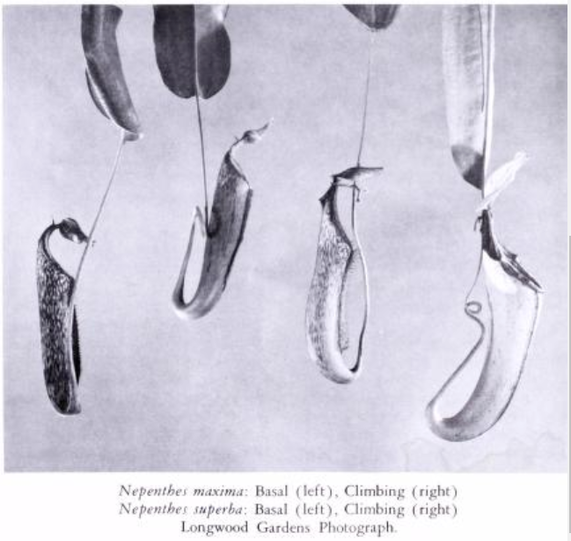
To make matters worse, Witte, Curator of Leiden Gardens, crossed in 1897 the two plants that Curtis had sent back. By then the two plants were considered N. maxima (curtisii) and N. stenophylla. The cross gave rise to the hybrid N. x wittei. Npenthes x wittei has the pitchers of N. curtisii, including the white band hidden by the large peristome, and the brittle foliage of our familiar Nepenthes stenophylla. All things taken into account, I believe our mystery plant of N. curtisii, N. spectabilis, N. maxima 'Superba' really to be the natural hybrid N. x curtisii (N. maxima x albo-marginata) and N. x wittei is N. x curtisii x N. stenophylla."
Which exact plant, pure species, natural hybrid, or man-made hybrid, was used in those early Victorian era crosses will probably remain forever a mystery. I have never observed the supposedly thin white band that Bruce Bednar references above in my Nepenthes maxima. Sarracenia Northwest occasionally offers cuttings of a plant that they purchased in the 1990's as Nepenthes curtisii. Curiously, it apparently has never produced lower pitchers. The upper pitchers do not seem to have the thin white band either, although it might just be difficult to differentiate from the very light green pitcher body in the available photographs.
Even the exact origin of my own Nepenthes maxima is mysterious! As a child, I used to swoon over a picture of a dark Nepenthes maxima pitcher in Peter's original Savage Garden book. I even put little hearts around it in gel pen! (It was the 90's... ) Imagine my happiness when I went to my first carnivorous plant show and run into (what I believe was) the VERY SAME plant!
The story - I purchased this as a small rooted cutting at the Bay Area Carnivorous Plant Society Show and Sale in 2012. I had just moved to the Bay Area to pursue my PhD in Biomedical Sciences at UCSF and heard about the show from California Carnivores. I got it from a Hawaiian nursery (can’t remember the name - but pretty sure it was Tristan's Carnivorous Plants) and they told me they originally propagated it from a rooted cutting obtained from California Carnivores. The handwritten tag it came with just says “N. Maxima female”. I am pretty sure that this is also the same Nepenthes maxima "dark" that Predatory Plants discusses in this species spotlight - it shares all of the same defining characteristics and they ALSO originally purchased theirs from California Carnivores. I do hope it is the same plant that I used to fawn over as a child - I certainly feel that way, because this is by far one of my favorite, if not THE favorite, plant in my collection!
The story - I purchased this as a small rooted cutting at the Bay Area Carnivorous Plant Society Show and Sale in 2012. I had just moved to the Bay Area to pursue my PhD in Biomedical Sciences at UCSF and heard about the show from California Carnivores. I got it from a Hawaiian nursery (can’t remember the name - but pretty sure it was Tristan's Carnivorous Plants) and they told me they originally propagated it from a rooted cutting obtained from California Carnivores. The handwritten tag it came with just says “N. Maxima female”. I am pretty sure that this is also the same Nepenthes maxima "dark" that Predatory Plants discusses in this species spotlight - it shares all of the same defining characteristics and they ALSO originally purchased theirs from California Carnivores. I do hope it is the same plant that I used to fawn over as a child - I certainly feel that way, because this is by far one of my favorite, if not THE favorite, plant in my collection!
Nepenthes maxima is a highly variable and adaptable species. I've grown it under MANY different windowsill and terrarium conditions. No matter what, it produces gorgeous wavy leaves and huge, colorful pitchers. Mine is just now starting to vine and hopefully it flowers again soon. I never had the space to actually pollinate and sow seed - now I do! If/when it does flower, I do hope to get some weird crosses on there!
Update November 2020
So my maxima hit the ceiling! Unfortunately no flowers, sigh. I decided to cut it back because the tip was starting to etiolate from lack of light. Too bad normal household windows block light to the top 10 inches of the room! I took a tip cutting and a 2 node cutting. The stems were so thick that I decided to try splitting the ends and stuffing a little long fibered sphagnum into it to increase surface area for new roots. I bagged them as best as I could (darn these super long internodes!) and placed them in my greenhouse terrarium where hopefully the warmth and high light will encourage quick rooting. The mother plant still has about 4 feet of vine on it - crossing fingers that an apical node activates so I can train the vine sideways in front of the window and get a flower! This plant is a beast and currently has 7 perfect pitchers on it and 3 that are in the process of dying back. Winter will slow it down a little bit though.
February 2021
Current Growing Conditions: South-Facing Living Room Window
Light: ~260 - 460 PPFD or 16530 - 20110 Lux (depends on the weather outside)
- Can withstand high light conditions without sunburn, leaves tend to bleach slightly but not redden
Humidity: ~80% night and 55% day
Temperature: ~68F night and 90F day (depends on weather outside)
Water: Moist but not wet
Potting Mix: 100% long fibered sphagnum
Fertilizer: MaxSea (1/4 tsp/gallon) every other week into pitchers
Additional Notes: Many different forms and varieties of Nepenthes maxima! All are highly adaptable, hardy, and vigorous growers and have beautifully marked pitchers, as well as the characteristic hump-like processes at the base and tip of the lid.
Light: ~260 - 460 PPFD or 16530 - 20110 Lux (depends on the weather outside)
- Can withstand high light conditions without sunburn, leaves tend to bleach slightly but not redden
Humidity: ~80% night and 55% day
Temperature: ~68F night and 90F day (depends on weather outside)
Water: Moist but not wet
Potting Mix: 100% long fibered sphagnum
Fertilizer: MaxSea (1/4 tsp/gallon) every other week into pitchers
Additional Notes: Many different forms and varieties of Nepenthes maxima! All are highly adaptable, hardy, and vigorous growers and have beautifully marked pitchers, as well as the characteristic hump-like processes at the base and tip of the lid.
Proudly powered by Weebly
